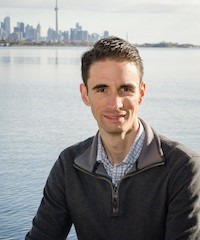Professor Matthias Sweet of Ryerson presented “Autonomous Vehicles: Public Policy Considerations and Consumer Interest in the Greater Toronto-Hamilton Area,” based on joint paper with Kailey Laidlaw, for the UT-ITE Friday Seminar Series on November 10, 2017.
In his presentation, Sweet discussed the results of a study gauging public interest, in the Greater Toronto-Hamilton Area (GTHA), in the adoption of autonomous vehicles (AVs). He highlighted the mode-centric policy in Ontario which favours the use of public transit and active modes of transportation over single-occupancy vehicles.
The study involved developing an internet survey and analysing the results through descriptive statistics and models. The survey gathered over 3,000 respondents from the regions of Durham, Halton, Hamilton, Peel, Toronto and York. It was geared towards evaluating interest in Private Autonomous Vehicles (PAVs) and Shared Autonomous Vehicles (SAVs).
Two key questions asked on the survey were:
- What premium would you be willing to pay for a PAV? and
- How often would you travel in SAVs at a given price?
Among the findings: younger, more technologically-savvy, and urban individuals will be more likely to use AVs.
At the end of the presentation, the speaker described three points of view when it comes to AVs:
- All AVs are cars;
- PAVs are cars and SAVs are transit; and
- Both PAVs and SAVs are transit.
Click here for a PDF of Matthias Sweet’s presentation.
Abstract
Autonomous vehicles (AVs) appear poised to transform urban transportation, but the direction and magnitude of change is unclear.
Private autonomous vehicles (PAVs) could be individually owned and induce sprawl and more driving. In contrast, fleets of on-demand shared AVs (SAVs) could reduce the need to own and use cars to travel.
While such normative visions currently shape the public discussion, for public policy to effectively manage this new technology, a better understanding of how consumers will adopt and use AVs is important.
This presentation discusses the transportation policy context in the Greater Toronto and Hamilton Area (GTHA) to identify potential implications of autonomous vehicles within the current policy context. Specifically, based on a consumer survey in the GTHA, this research seeks to understand the conditions under which consumers will adopt and use AVs.
A survey was administered to 3,201 respondents in November 2016 and asked questions related to individual and household characteristics, commuting and travel, and preferences for AVs.
Ordered probit models were estimated to explore demand for PAVs or SAVs (estimated independently for trips to/from transit and for other trips).
Findings identified common interest in both PAVs or SAVs among young, urbanites, those with flexible work schedules, the tech-savvy, current Uber users, and chauffeurs. PAV adopters are expected to be auto users with cars costing more than $30,000. In contrast, SAV users are expected to be current commuters by non-auto modes and indicate significant potential for SAV trips to both substitute for and complement non-auto commuting.
Overall, findings suggest that AVs are likely to disrupt current travel patterns and particularly transportation policies designed to increase non-auto mode shares.
Short Bio

Dr. Matthias Sweet is an Assistant Professor at Ryerson University’s School of Urban and Regional Planning, with research interests in transportation policy, land use planning and urban economics. His previous work includes investigating the role of transportation services and traffic congestion in transportation-land use interactions, regional spatial structure and change, and travel behaviour. His current work explores how technology may change cities both in terms of how urban planners conduct their work (e.g. Big Data) and how cities’ transportation systems evolve and are planned (e.g. self-driving cars). Sweet received his PhD in City and Regional Planning from the University of Pennsylvania in 2012, and holds an MA and a BA in Geography, from the University of Georgia and Appalachian State University respectively.
—————————-
This seminar was presented by the University of Toronto Institute of Transportation Engineers (ITE) Student Chapter.
